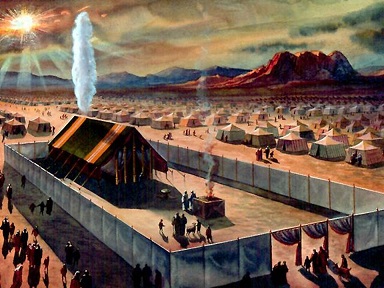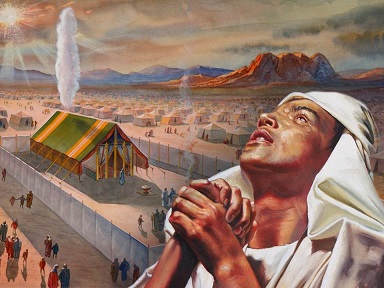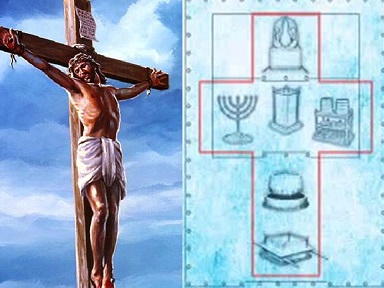
The Priesthood of the Sanctuary

Samuel Smith
23 Jan'19
5
LESSON 2
THE PRIESTHOOD OF THE SANCTUARY
You are welcome to another edition of Insights from God's Word, a Bible study programme that is committed to sharing God's Word by allowing the Bible to speak for itself.In this edition, we continue with our series on His Way is in the Sanctuary. The topic for this study is: The Priesthood of the Sanctuary. When God led the Israelites through the wilderness, He commanded Moses to build Him a sanctuary so He will dwell among them (see
1) THE SELECTION OF THE PRIESTHOOD
When Israel apostatised by worshipping the golden calf in the wilderness, the tribe of Levi responded to the solemn appeal of Moses, and took their stand for the Lord. They then executed the divine judgement in destroying their unrepentant brethren (seeTwo groups of people from the tribe of Levi ministered in relation to the tabernacle. They are generally referred to as the Levites and the Priests. It is important to note that the Priests were also Levites, but in addition, were descendants of Aaron, the brother of Moses. Thus, we can say that all Priests were Levites, but not all Levites were Priests. Even though the Levites had a part to play in relation to the tabernacle during the Exodus (such as keeping the instruments of the tabernacle, setting up and taking down the tabernacle, and preparing it for transport), the special duties of priesthood in the sanctuary were reserved for Aaron and his sons (see
2) THE WORK OF THE PRIESTHOOD
The work of the priests was directly related to the services of the sanctuary. The high priest was the main priest of the tabernacle. He could work in all parts of the sanctuary including the Most Holy Place. The other priests played a subsidiary role to the high priest. The work of the other priests ended at the first apartment of the tabernacle.The priests worked at the Holy Place and court of the tabernacle daily. For instance, every morning and evening, the high priest tended the Golden Lampstand at the Holy Place by trimming its wicks and renewing the oil. The Lampstand was the only source of light at the Holy Place, and had to be always lit to ensure the smooth daily ministration of the priesthood at this sacred apartment (see
Besides their usual work at the Holy Place, the priests also worked daily at the court on various kinds of offerings (see
It is important to note that the priests also had the sacred duty of pronouncing blessings on the children of Israel (see
Because of their sacred work, the priests were to model an exemplary lifestyle for the people to follow in all the ways of Jehovah. For instance, the Lord commanded the priests through the prophet Moses the following:
10:10 And that ye may put difference between holy and unholy, and between unclean and clean;
10:11 And that ye may teach the children of Israel all the statutes which the LORD hath spoken unto them by the hand of Moses."
(
3) THE GARMENTS OF THE PRIESTHOOD
The Lord commanded Moses to design special garments for the priests to distinguish them from the rest of the people. The garments of the priests were consecrated to Jehovah, and designed for glory and for beauty (seeThe high priest on the other hand wore two different kinds of garments. The first of these garments was the "golden garments" which he wore all year round. This garment consisted of an ephod, a breastplate, a robe, a tunic, a turban, a belt, a crown, and a pant (see
The garments of the priesthood had great significance in relation to their sacred work on behalf of the people. We can summarise the following information from Scripture in relation to the significance of the priestly garments:
i) The high priest wore an EPHOD which was made to carry 2 onyx stones on its shoulders. Six of the names of the tribes of Israel were inscribed on one stone and the other six names on the other stone, in order of their birth. As the high priest stood before the Lord in the tabernacle with the 2 onyx stones in his ephod, he represented the whole congregation of Israel. The ephod was made of gold, blue, purple, and scarlet thread, and fine woven linen, artistically worked (see
ii) The high priest wore a colourful BREASTPLATE with 12 stones. Just as the 2 stones in the ephod, the 12 stones in the breastplate also signified the fact that the high priest stood as a representative for all the 12 tribes of Israel in the sanctuary. There were pockets in the breastplate where the high priest placed the Urim and Thummim. The Urim and Thummim were lots that the high priest utilised to seek the will of God. The breastplate was also made of gold, blue, purple, and scarlet thread, and fine woven linen (see
iii) The high priest wore the ROBE OF THE EPHOD which was woven of blue threads and had no sleeves. The artisans made upon the hem of the robe pomegranates of blue, purple, and scarlet, and of fine woven linen. They also made bells of pure gold, and put the bells between the pomegranates on the hem of the robe all around. The bells alerted the Divine Presence of the high priest's approach so he does not perish as he ministered in the sanctuary (see
iv) The high priest wore a sacred CROWN OF GOLD, engraved with the words: "Holy to the Lord" (see
v) All the priests wore TUNICS which were made of linen, and worn under the outer garments (see
vi) All the priests wore PANTS (trousers) that was supposed to fully cover their nakedness when they came to minister before the Lord. This item in their garments was very significant because if they appeared before the Lord not well covered, they were to be struck dead (see
vii) All the items that constituted the uniform of the priests (such as the hat, sash, pant, tunic, turban, robe, ephod, breastplate and crown) were designed to convey sacred glory and beauty. They were purposely designed for the service of God in the sanctuary, and thus sanctified or separated the office of the priesthood from the rest of the congregation (see
viii) More so, the major colours in the garments of the priesthood (which were also found in other areas of the sanctuary), were all symbolic in relation to the solemn work of atonement that was performed by the priests. For instance, the fine woven linen (white) was a symbol of Christ's purity or righteousness (see
4) CHRIST: THE ANTITYPICAL HIGH PRIEST
In the selection, work and garments of the priesthood, the ministry of Christ for the fallen race of Adam was typified. Even as the priests were specially selected, so was Christ specially selected to be the propitiator for mankind even before the foundation of the world (seeIn the work of the priesthood, the mediatorial ministry of Christ to bring mankind back to the loving arms of God is clearly typified. Beloved, it is important to note that after the death of Christ on the cross, the work of the human priests came to an end (see
Exhortation: Beloved, even as the priests of the sanctuary were called to model an exemplary lifestyle for the people of Israel, so does Christ expect all believers to do the same for the peoples of the world. Through the inspiration of the Holy Spirit, the apostle Peter wrote the following: "But ye are a chosen generation, A ROYAL PRIESTHOOD, an holy nation, a peculiar people; that ye should shew forth the praises of him who hath called you out of darkness into his marvellous light" (
In our next study, we will consider the topic: The Services of the Sanctuary. The Bible study references for this study are
Stay blessed and keep shining for King Jesus.
Maranatha!
Powered by White Throne Ministries











